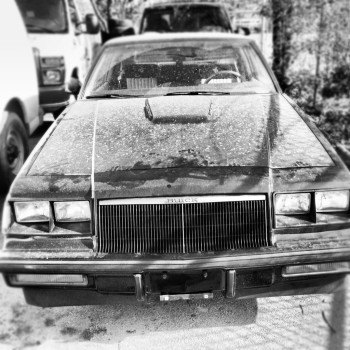Don't Invest In These "Investment" Cars

Get any group of car enthusiasts together and they’ll eventually start arguing about which recent models will increase in value over the next twenty years. I don’t think it’s actually possible for assembled gearheads not to discuss this topic, usually somewhere in between stories about past speeding tickets and bashing the Toyota Corolla.
As a result, “investment” cars have been covered quite a bit. But here’s an interesting variation: which cars won’t increase in value? Of course, the easy answer is “most of them.” But more specifically, which recent cars are people holding on to, hoping for a value increase that just won’t come?
These are my predictions, and – as always – I soon expect to hear just how wrong I am.
Buick Grand National
We can all agree the Grand National is an unbelievably cool car. Debuting at a time when the size of an average Buick was outdone solely by the thickness of its owners’ glasses, the Grand National went like a Corvette despite possessing the aerodynamics of a file cabinet.
But here’s the problem: Buick built 30,000 Grand Nationals and sold each one to a casual collector who expected it to shoot up in value “someday.” Owners would bring guests to the house, show them the Grand National and loudly announce: “This is Junior’s college fund.” As a result, every single Grand National is currently parked in a climate-controlled garage with zero miles and a laminated window sticker. With so many examples built and so many of those in perfect shape, don’t expect to see values jump.
E28 BMW M5
I’ve noticed a growing trend among E28 M5 owners to price their cars as if they were Silicon Valley homes during the waning days of the Clinton administration. Seriously: there is one on AutoTrader.com near me that has 194,000 miles and a $20,000 asking price. I write this having not actually verified its continued presence on AutoTrader because, let’s be honest, it’s still there.
E28 M5 owners are convinced that their cars will soon appreciate like the E30 M3. Unfortunately, they’ve forgotten that the E30 M3 was the lightweight sports car that began an era, while the E28 M5 was a vaguely sporty sedan with really long shift throws. My suggestion to E28 M5 owners: enjoy your cars, because they’re amazing. But stay out of the $20,000 price range.
Ferrari 308/328
One day, I might have to eat these words. But right now, it’s hard to imagine 308 and 328 values staying anywhere but exactly where they are.
The 308 and 328 are very cool cars that look like they’re doing 200 miles per hour even when they’re sitting still. But they don’t quite have the guts to back up the styling. In fact, with its 240 horsepower, the 308 could barely crest 150 mph, let alone 200. The 328 was a bit meatier, but that doesn’t matter much in today’s world of Camrys that do 0-to-60 in six seconds.
Sure, performance isn’t everything. The Dino, for example, could barely outrun an old MG – but its values are now creeping into Daytona territory. Very true. But while there are 2,500 Dinos in this world, Ferrari built more than 12,000 308s and another 7,000 328s. The huge production numbers virtually ensure they will always remain a used car, and not a collector car.
2002-2005 Ford Thunderbird
I sincerely hope that no one bought the ’02-’05 Thunderbird as an investment. But if you did, you’ll have a rude awakening when it comes time to sell and you discover the T-Bird is worth only a little more than the Lincoln LS on which it’s based.
Like the Prowler below, the eleventh-gen Thunderbird is a case of an automaker trying too hard. Of course, it worked out for Ford: they sold every unit, and early ones were probably very profitable. But the Thunderbird’s biggest market was old people nostalgic for old Thunderbirds. Young people never latched on, which doesn’t bode well for its future as a collectible car.
Any “Indy Pace Car” Edition
I have a confession to make: I love Indy Pace Car Editions. Seriously. Yes, even that purple Corvette with the yellow wheels.
But unfortunately for people who own them, I’m basically one of one. Most people see Indy Pace Car Editions for precisely what they are: a manufacturer eeking out a few extra sales by taking a normal car and adding stickers. And, sometimes, yellow wheels.
As a result, don’t ever buy an Indy Pace Car Edition as an investment. Unless, of course, it actually paced Indy. Which it never did.
Plymouth Prowler
When the Plymouth Superbird came out all those years ago, no one ever expected its values to go anywhere. As the famous story goes, it was actually highly unpopular, which isn’t hard to believe considering its rear wing looked like an industrial-strength staple, possibly created by Paul Bunyan.
The problem with the Prowler is that it’s the exact opposite. It’s trying too hard to be cool, which virtually ensures that it will end up in the history books as gloriously uncool. The fact that its V6 came from the Dodge Intrepid and its center stack from the Chrysler parts bin only seals the deal: the Prowler will never climb in value. Even if you have the little trailer.
Porsche 997 Speedster
Before the 997 model, every single 911 Speedster was priced from the factory like a slightly more expensive 911. People bought them, stored them in inflatable bubbles, and watched values soar.
This time, Porsche wanted that value jump for itself – and they priced the 997 Speedster accordingly. For $204,000, you got unique wheels, a distinctive windshield, a weird top and a slight horsepower bump over the regular 997 Carrera S – which, by the way, was half the price. Values entered free-fall before the cars even sold out.
Of course, 997 Speedster values will, one day, climb again. But it will be many years – and a lot of inflation – before they ever return to the $200,000 mark.
So, tell me: am I wrong? Did I miss anything? What cars do you think are being stored in dirt-free controlled garages by owners who have unrealistic expectations about future values?
Doug DeMuro operates PlaysWithCars.com. He’s owned an E63 AMG wagon, road-tripped across the US in a Lotus without air conditioning, and posted a six-minute lap time on the Circuit de Monaco in a rented Ford Fiesta. One year after becoming Porsche Cars North America’s youngest manager, he quit to become a writer. His parents are very disappointed.

More by Doug DeMuro
Latest Car Reviews
Read moreLatest Product Reviews
Read moreRecent Comments
- Honda1 Unions were needed back in the early days, not needed know. There are plenty of rules and regulations and government agencies that keep companies in line. It's just a money grad and nothing more. Fain is a punk!
- 1995 SC If the necessary number of employees vote to unionize then yes, they should be unionized. That's how it works.
- Sobhuza Trooper That Dave Thomas fella sounds like the kind of twit who is oh-so-quick to tell us how easy and fun the bus is for any and all of your personal transportation needs. The time to get to and from the bus stop is never a concern. The time waiting for the bus is never a concern. The time waiting for a connection (if there is one) is never a concern. The weather is never a concern. Whatever you might be carrying or intend to purchase is never a concern. Nope, Boo Cars! Yeah Buses! Buses rule!Needless to say, these twits don't actual take the damn bus.
- MaintenanceCosts Nobody here seems to acknowledge that there are multiple use cases for cars.Some people spend all their time driving all over the country and need every mile and minute of time savings. ICE cars are better for them right now.Some people only drive locally and fly when they travel. For them, there's probably a range number that works, and they don't really need more. For the uses for which we use our EV, that would be around 150 miles. The other thing about a low range requirement is it can make 120V charging viable. If you don't drive more than an average of about 40 miles/day, you can probably get enough electrons through a wall outlet. We spent over two years charging our Bolt only through 120V, while our house was getting rebuilt, and never had an issue.Those are extremes. There are all sorts of use cases in between, which probably represent the majority of drivers. For some users, what's needed is more range. But I think for most users, what's needed is better charging. Retrofit apartment garages like Tim's with 240V outlets at every spot. Install more L3 chargers in supermarket parking lots and alongside gas stations. Make chargers that work like Tesla Superchargers as ubiquitous as gas stations, and EV charging will not be an issue for most users.
- MaintenanceCosts I don't have an opinion on whether any one plant unionizing is the right answer, but the employees sure need to have the right to organize. Unions or the credible threat of unionization are the only thing, history has proven, that can keep employers honest. Without it, we've seen over and over, the employers have complete power over the workers and feel free to exploit the workers however they see fit. (And don't tell me "oh, the workers can just leave" - in an oligopolistic industry, working conditions quickly converge, and there's not another employer right around the corner.)






































Comments
Join the conversation
Clean low mileage Grand National: www dot northstateauto dot com/web/3107/vehicle/6073065/1987-Buick-Grand%20National What I'm wondering is who was crazy enough to trade in a clean low mileage Grand National. They must have gotten severely hosed on the trade-in.
Oh how I love to log into these sites year's later to see how wrong people were in their "predictions" .. Let's see - Clean GNX examples went for $165,000 in Palm Beach in 2015 - and $220,000 in 2017. As for regular Grand Nationals, clean low mile examples are going for $35,000 to $45,000. Where is Doug DeMuro today ?????